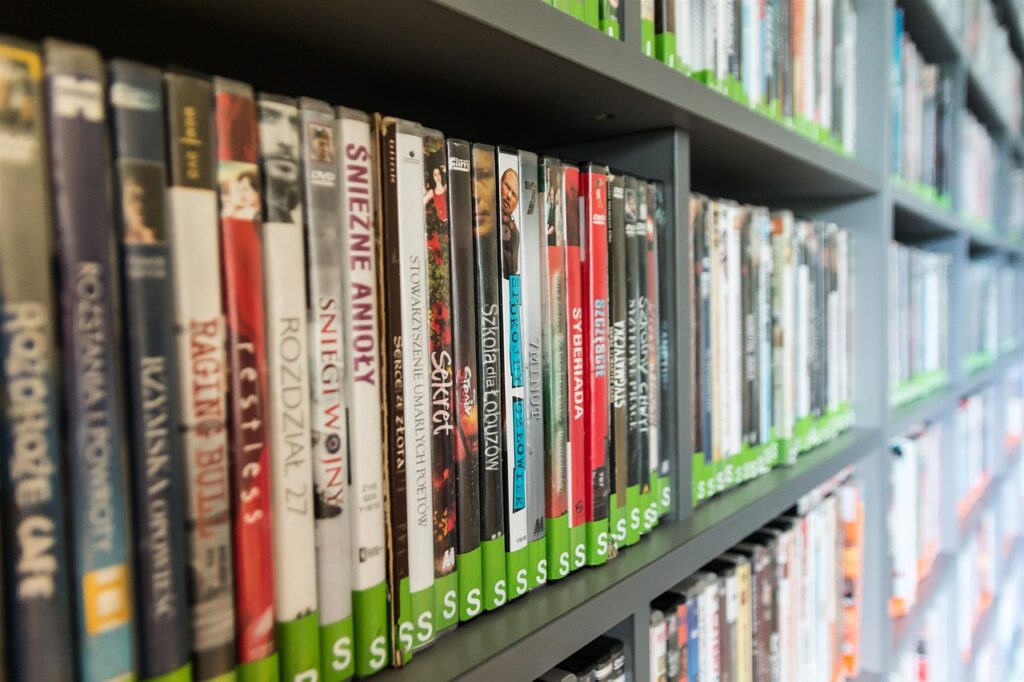Table of Contents
We live in an era where most people live the majority of their lives online; so it’s only natural that most of the media they consume would be on the internet. The popularity and prevalence of streaming services have ensured that everything is ‘content’ in the eyes of the mainstream audience.
This is an age where a 30-second TikTok video and Sam Peckinpah’s The Wild Bunch are viewed as the exact same thing by people. While this may be an inviting proposition for younger people who now have more access than ever; it can feel somewhat jarring for people who have been consuming art and entertainment in traditional forms for many decades.
While instant access to all forms of digital media at any time is progressive in many ways; it has no doubt come at a cost. The prominence and importance of actual physical media has declined severely. A lot of people do not see the point of buying DVDs, CDs, Blu-rays, physical video game copies, and vinyls. They also have minimal interest in buying magazines, print publications, paperbacks, and comic books.

This has had a significant impact on the global entertainment industry, and its relationship to the audience and consumers. It has affected the ways in which people respond to traditional forms of entertainment consumption, and their overall shelf-life and cultural impact.
DVD sales are reported to be declined 80% since 2008. In fact, in 2023, DVD sales recorded consistent lows for the sixteenth straight year. The overall physical media sales in the U.S. decreased to $754 million, down from $1.05 billion in 2022. In fact, major retail stores like Best Buy have announced that they will stop selling physical media altogether. Yep, these are indeed worrying times.
No doubt all of this has had a worrying economic impact. Let’s observe more below.
What are the economic implications of the decline in physical media?
Let’s get the facts straight: physical media is not just a vanity for fans to indulge in, it is also a source of revenue for film industries across the globe. Every bit as noteworthy and important as the theatrical revenue.
In fact, a lot of great movies you watched, including some of your favorites–didn’t make their money back during their theatrical run. Strong DVD and home video sales helped them thrive post-release and allowed them to have cult followings. That often led them to be re-discovered, and even get eventual sequels. Not to mention, this helped the careers of the directors and the actors as well. And helped encourage bolder, more creative, risk-taking voices to be heard.
Streaming pretty much put a damper on all of that; with money now going to the tech companies instead of the studios. This means that there is no guarantee that the studio will make their investment back on mid-budget vehicles. And their risk-averse nature means that only high-budget, mass-market blockbuster films that cater to all demographics (cough especially China *cough) are greenlighted.
While technically people may argue that mid-budget movies do exist; they are almost always found on popular streaming services like Netflix and Amazon Prime. So why complain? Because they are also part of the problem.
This brings us to the next point….
Why making streaming-specific movies is not the answer
It’s no secret that the movies and TV shows streaming services put out are pretty much commercials for their own brand. These movies are not mainstream entertainment built to satisfy a large audience, or artistic auteur-driven films that make you contemplate. There are pretty much cynically designed films with generic elements that create 90 minutes worth of footage that remains on top of streaming charts. Even if most of the time, they are awful.

There have been complaints recently of generic-feeling, formulaic, recycled plots, directors, and casts in all of them. Those complaints are indeed valid. These movies are feature-length commercials with no cinematic value, designed to attract first-week streaming numbers, and then fade away into obscurity.
Attracting big-name directors, stars, influencers, and musicians to haphazardly package them into forgettable junk haphazardly does not make for great art or entertainment. Nor does it inspire people creatively.
You may watch the latest Ryan Reynolds mediocrity on opening day, but would you ever want to buy a DVD? Or stick a poster up on your room wall?
COVID-19 and multiplex boredom
Streaming services may invite cynicism, but truth be told the divide between the creative industry and audiences has been growing for quite a while.
The global box office has been suffering for quite a bit; with alarmingly declining numbers. Suggesting that even the mainstream audience has been growing exhausted.
A big reason why people stopped going to the theatre and buying movies physically, is also because most of the movies just flat out suck. None other than Steven Spielberg predicted the collapse of the film industry back in 2013, and at this point, it is safe to say that he has been proven prophetic.
There has also been a backlash against ‘woke’ political messaging in mainstream films. Where a large majority of people feel angered by forced socio-political messaging that they feel is often unwittingly forced into movies unnecessarily. Not to mention, it does not translate well to overseas audiences, who may or may not care about the socio-political landscape of the US.
The COVID pandemic was the tipping point in some ways. Filmmakers and studios (begrudgingly) released a large catalogue of their movies on streaming, and audiences decided it was much easier (and cheaper) to watch movies in the comfort of their homes. If they didn’t like it, they could always switch to other things.
This eventually created a film-watching habit that (as mentioned above) gave more power than ever to streaming services; and stripped some away from the studios and the traditional physical media market.
The impact on the video game industry
Look across the other side of the pond, to the video game industry, and you will find a not-too-dissimilar story. Bloated AAA budgets, exorbitant spending, declining creative output, and a startling decline in physical copies of games. Big-budget developers releasing unfinished games that fail to break even despite massive sales, due to the excess cost of development.
Alan Wake 2, notably one of the best-reviewed games of 2022, did not notoriously release on physical media on release. This was met with widespread criticism across the industry and was listed as one of the reasons why it performed poorly sales-wise. Elsewhere console sales have also been on a rapid decline, with both PS5 and XBOX not performing to the level that they’re expected to.
Ironically, digital and streaming seemed to have helped the gaming industry. Where a lot of AAA developers have dared to leave their cushy corporate jobs and branch into the indie gaming scene. Which then led to the creation of some of the most creative and innovative games. Made at a fraction of the budget, but creating 10x the fun and creativity. I mean seriously, have you played HUNTDOWN? It rules!
Environmental point of view
It’s important to keep a balanced perspective, and there is always another one to the prevailing one. Sure, you and I may mourn the lack of ‘old-school’ filmmaking and physical media; but to the emerging generation, it is a godsend. Sure, Generation ‘Z’ may appear to be a live-action version of a Monty Python skit, but they do make some salient points.
Sure, your upper-middle class, ‘socially liberal’, early 20s colleague may point out the various ways streaming helps in CO2 efficiency and reduces the environmental pollution and wastage caused by discs. And to be fair, she’s not completely wrong. So it’s important to keep her feelings in consideration as well, after all, it is empathy that leads to a shared mindset.
LOL.
Anyways, moving on to the next topic.
The lost communal and cultural experience
Since we have covered the necessary financial and social implications, let’s move on to the most important ones: The personal connection one has to movies/pop culture. Speaking from a personal perspective, I loved splurging money on physical media, and I always considered it a point of pride to own limited collectors’ edition memorabilia and movie posters.Despite their high prices, I was more than happy to pay them. As I felt they would help support the filmmakers, movies/games/artists I respect.
In fact, both fans and filmmakers love the communal and culture-based aspects of films. Hence, the DVDs were filled with extra interviews, set outtakes, deleted scenes, and in-jokes that passionate filmmakers loved sharing with audiences. The fans themselves devoured it and helped build myths and theories around movies that made the whole thing so much more fun.
Now all that is (mostly) gone, and the incentives to fun things like host revival screenings, events, etc., aren’t as strong as they were. Not to mention, the increased inflation and ticket prices make it harder than ever to do so. The only’ fan interaction’ these days seems to be ‘hate-watching’ and ‘review bombing’. These two hobbies are very toxic in nature and add nothing of value except to encourage other nasty, confrontational online behaviour. That seems to be where we’re at these days.
The preservation counter-culture
While things may look dire, all is not lost. The dilution of modern film culture has led to a new wave of old-school cinephiles fighting back against current trends and trying to evoke what was great in the past. While things may look dire on the outside; some hope still remains.
It is worth watching Konbini’s excellent video series, shot in the ‘last video store’ in the world, Paris.They regularly get prominent figures in the film industry to explore and reminisce over their favourite films, to evoke a good sense of nostalgia towards physical media. There has also been a trend of some great YouTubers doing content that encourages a revival of video stores.
It can sometimes be heartening to watch Generation Z YouTubers come across John Carpenter’s The Thing and have their minds blown. If that isn’t heartening, I don’t know what is.
So, what are your thoughts?
Let us know what your thoughts are. Are you the type that loves the physical intimacy of DVDs, CDs, and vinyls? Or are you the one who thinks that Killer Klowns From Outer Space being on Amazon Prime is actually the best way to watch it? Are you the type that will go to revival screenings of Andrej Zulawski’s Possession (1981) when you get free time? Or do you think it’s lame arthouse horror-schlock best seen at home while you save up to pay full price for Taylor Swift’s Eras Tour concert movie?
Keep us posted about your thoughts on the future of film in the comments section below. Share your opinions, likes, and interests with us. And if you’re interested in joining the conversation as a writer for MindBrews, reach out—let’s give your voice a stage.
Write to us at [email protected]